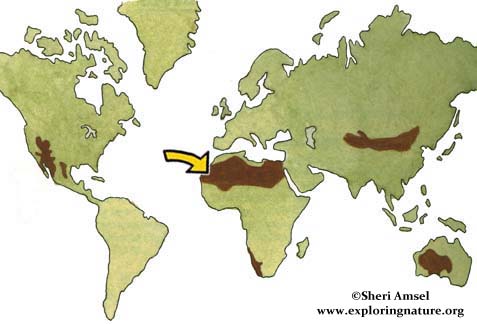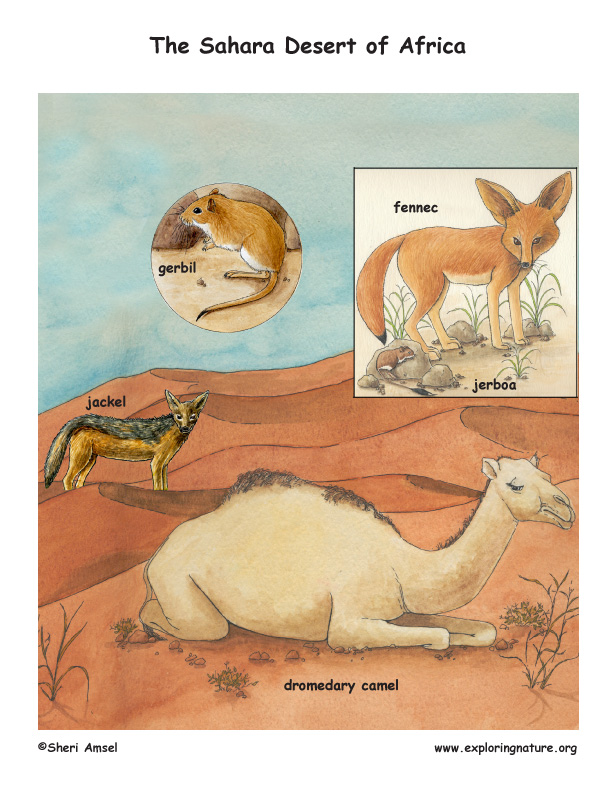

The Sahara is the largest hot desert on earth. It is as big as the entire United States, stretching from the Atlantic Ocean to the Red Sea. It covers many countries in Africa. The Sahara is one of the hottest and driest of the world's deserts with temperatures up to 136° F. Less than one inch of rain falls each year. Some years, the rain never comes at all. Only creatures specially adapted for the severe conditions, like the camel, can survive here.
There are many kinds of land in the Sahara. Great flat areas of gravel and stone, rocky plateaus, mountains, and vast seas of endless sand all make up this huge desert. The great sandy areas are called ergs. The Sahara's ergs have huge wind-blown dunes, some up to 600 feet tall. The greatest erg is in Libya and is as large as the whole country of France. Small oases of water are found throughout the Sahara. In these places, a few people can live and even grow crops. Where water is near, herbs and small shrubs can grow. Deep-rooted trees survive in wetter areas.
In the cool of the evening, the tiny fennec fox comes up from its underground tunnel to hunt for mice, birds, and lizards. Its huge ears help it hear the smallest scurry. It has adapted well to the desert and rarely needs to drink. Gerbils also live underground in the heat of the day. At night they come out to search for seeds, roots flowers and insects, careful to avoid the larger animals hunting them. When in danger, they stay very still. Their colors blend with the desert, making them difficult to see. If they must escape they use their powerful jumping legs to get a fast head start. The addax antelope were once all over the Sahara. It can live without water and gets the moisture it needs from the plants it eats. Now, because of over hunting by humans, there are few addax left. They are protected by law. The large barbary sheep also can scrape by in the desert with little food and almost no water. Other animals found in the sahara include hyena, antelope, gazelle, oryx, jackals, badger and baboon.
Plants that can survive the heat, drought and salt of the Sahara desert include; the olive tree, acacia, cypress, mastic tree, oleander, thyme, and grasses.
When you research information you must cite the reference. Citing for websites is different from citing from books, magazines and periodicals. The style of citing shown here is from the MLA Style Citations (Modern Language Association).
When citing a WEBSITE the general format is as follows.
Author Last Name, First Name(s). "Title: Subtitle of Part of Web Page, if appropriate." Title: Subtitle: Section of Page if appropriate. Sponsoring/Publishing Agency, If Given. Additional significant descriptive information. Date of Electronic Publication or other Date, such as Last Updated. Day Month Year of access < URL >.
Amsel, Sheri. "Sahara Desert of Africa" Exploring Nature Educational Resource ©2005-2024. December 13, 2024
< http://www.exploringnature.org/db/view/Sahara-Desert-of-Africa >

